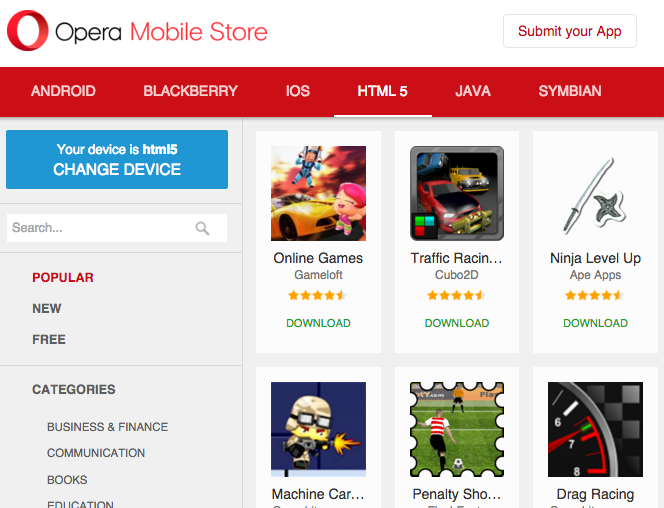Developing an app takes time and money. When it’s ready to launch, you want to do everything you can to ensure a solid return on your considerable investment.
According to Fueled, more than 25 percent of apps on Apple’s iOS platform earn over $5,000 per month, and on Android, 16 percent reach the same threshold. On Apple’s store, you’re competing with 1.5 million other apps, and with Google Play, over 1.6 million apps.
Alternative app stores can give you more options. Some have better revenue plans, whilst others give access to a particular customer profile. With less competition, your app has the potential to become a big fish in a small pond. Diversifying beyond the two primary app stores also allows you to survive any hiccup in the big stores.
Here are five alternative app stores that you should consider.
1. Amazon Underground

Amazon Underground is for apps on Amazon Fire tablets, Android, and Blackberry 10 devices that have the Amazon Underground app installed. If you don’t charge for app downloads or in-app fees, the store pays based on how long your users spend using your apps. The theory behind Amazon Underground is that the free features attract more users and developers can focus on the customer’ experience instead. Instead of receiving money from the users, you’re getting paid by Amazon.
There are a some caveats. To qualify, you have to have a paid component to the app (in-app purchases or charge a fee for use) and it has to have features “…substantially similar to or better…” than anything similar on other app stores.
2. GetJar
GetJar, which features 70,000 mobile apps, offers distribution to developers for free. Requirements are minimal, and you’ll reach more than 2,300 phones. There are more than three million downloads per day through GetJar, and the founder of the company, Ilja Laurs, said that the most valuable thing about his company is that they provide distribution on a massive scale. GetJar has 849,036 mobile apps available on its platform that users of Java ME, BlackBerry, Android, Windows Mobile, and Symbian can download.
The submission process is painless and approvals don’t take long. Get started at developer.getjar.com/login.
3. AppBrain
AppBrain, which lists apps from the Google Play store, has a pay-per-install system for Android apps and their developers. When you add your app to their catalogue through Google Play, they also give you free access to AppLift SDK, which gives you analytics on your app that you can use to show advertisers. The platform will also suggest actions (‘apptimize’) when finding weaknesses in your app. Currently, there are 50,000 people using the SDK to monetize their apps.
4. Opera Mobile Store

The Opera Mobile Store contains more than 300,000 mobile apps for over 7,500 phone models including BlackBerry, Windows Phone, Android, and iOS. Apps are sold in over 250 countries to 105,00,000 visitors each month, and 2,000,000 apps are downloaded every single day.
Registration for your app is free and you do not have to remove any in-app downloads, the platform doesn’t get involved with that aspect of your business model. Developers receive 70 percent royalties from their apps on BlackBerry, Symbian, and Android after taxes and transaction costs are deducted. For Java, the split is 50/50.
5. Amazon
The Amazon store accepts Android, Fire TV, and web apps for its store. Like the Opera Mobile Store, developers will receive 70 percent of sales. Apps can be free or cost money, are available in more than 200 countries, and are exposed to tens of millions of Amazon customers. If you submit you app for marketing consideration and it’s accepted, Amazon will promote it for you through social media channels and on the store fronts on the Amazon website, Fire tablets, and mobile devices.
What’s to Lose?
If you want additional exposure and the chance to earn more revenue, you should investigate some of the alternative app stores. Though Apple and Android have the largest market share, there is nothing to lose from adding your app to other app stores. It could have a big impact on your revenue and gain you new customers in different markets.
Frequently Asked Questions (FAQs) about Alternative App Stores
What are the benefits of using alternative app stores?
Alternative app stores offer a variety of benefits that can be advantageous for both developers and users. For developers, these platforms often provide a less crowded marketplace, which can increase the visibility of their apps. They also typically offer a higher revenue share compared to mainstream app stores. For users, alternative app stores can offer a wider variety of apps, including those that may not be available on mainstream platforms. Additionally, they often provide more personalized recommendations and a more user-friendly interface.
Are alternative app stores safe to use?
While alternative app stores can offer a variety of benefits, it’s important to note that not all of them are created equal. Some may not have as stringent security measures as mainstream platforms, which can potentially expose users to malware or other security risks. Therefore, it’s crucial to do your research and choose reputable alternative app stores. Look for platforms that have clear security policies and a history of promptly addressing any security issues.
How can I increase my app’s visibility on alternative app stores?
There are several strategies you can use to increase your app’s visibility on alternative app stores. First, make sure your app is optimized for the platform’s search algorithm. This can involve using relevant keywords in your app’s description and title, and ensuring your app’s icon and screenshots are eye-catching. Additionally, consider leveraging the platform’s promotional opportunities, such as featured listings or sponsored placements.
What are some popular alternative app stores?
There are numerous alternative app stores available, each with its own unique features and benefits. Some popular options include Amazon Appstore, which offers a wide variety of apps and games; SlideME, which focuses on premium apps; and GetJar, which provides free apps for a variety of platforms. Other notable alternative app stores include Opera Mobile Store, AppBrain, and F-Droid.
Can I sell my app on multiple app stores?
Yes, you can sell your app on multiple app stores. In fact, doing so can be a great way to increase your app’s visibility and reach a wider audience. However, it’s important to note that each app store has its own submission process and requirements, so you’ll need to ensure your app complies with each platform’s guidelines.
How do alternative app stores handle app updates?
The process for handling app updates can vary between different alternative app stores. Some platforms may automatically update apps, while others may require users to manually download and install updates. As a developer, it’s important to regularly update your app to ensure it remains functional and secure.
What is the revenue share on alternative app stores?
The revenue share on alternative app stores can vary, but it’s typically higher than on mainstream platforms. For example, some alternative app stores offer a 70-30 revenue split, with 70% going to the developer. However, some platforms may offer an even higher revenue share. It’s important to carefully review each platform’s terms and conditions to understand their revenue share model.
Can I use alternative app stores if my app is rejected by mainstream platforms?
Yes, if your app is rejected by mainstream platforms, you can consider submitting it to alternative app stores. These platforms often have less stringent submission requirements, which can make it easier for your app to be accepted. However, it’s important to ensure your app complies with each platform’s guidelines to avoid potential issues.
How can I ensure my app is successful on alternative app stores?
Ensuring your app is successful on alternative app stores involves a combination of effective marketing, regular updates, and providing a high-quality user experience. Make sure your app is optimized for the platform’s search algorithm, leverage promotional opportunities, and regularly engage with your users to encourage positive reviews and ratings.
Are there any downsides to using alternative app stores?
While alternative app stores can offer numerous benefits, there can also be potential downsides. These can include a smaller user base compared to mainstream platforms, potential security risks, and varying levels of customer support. Therefore, it’s important to carefully consider these factors when deciding whether to use alternative app stores.
 Robyn Tippin
Robyn TippinRobyn Tippins is the Co-Founder of Mariposa Interactive. Robyn has been managing online communities for over 20 years, starting at AOL in the mid-90s. A front-end designer, community manager, digital marketer and history buff, Robyn is fascinated by human behavior.





